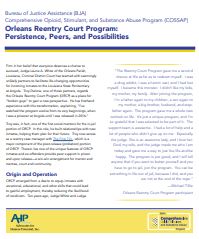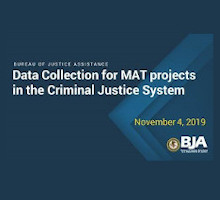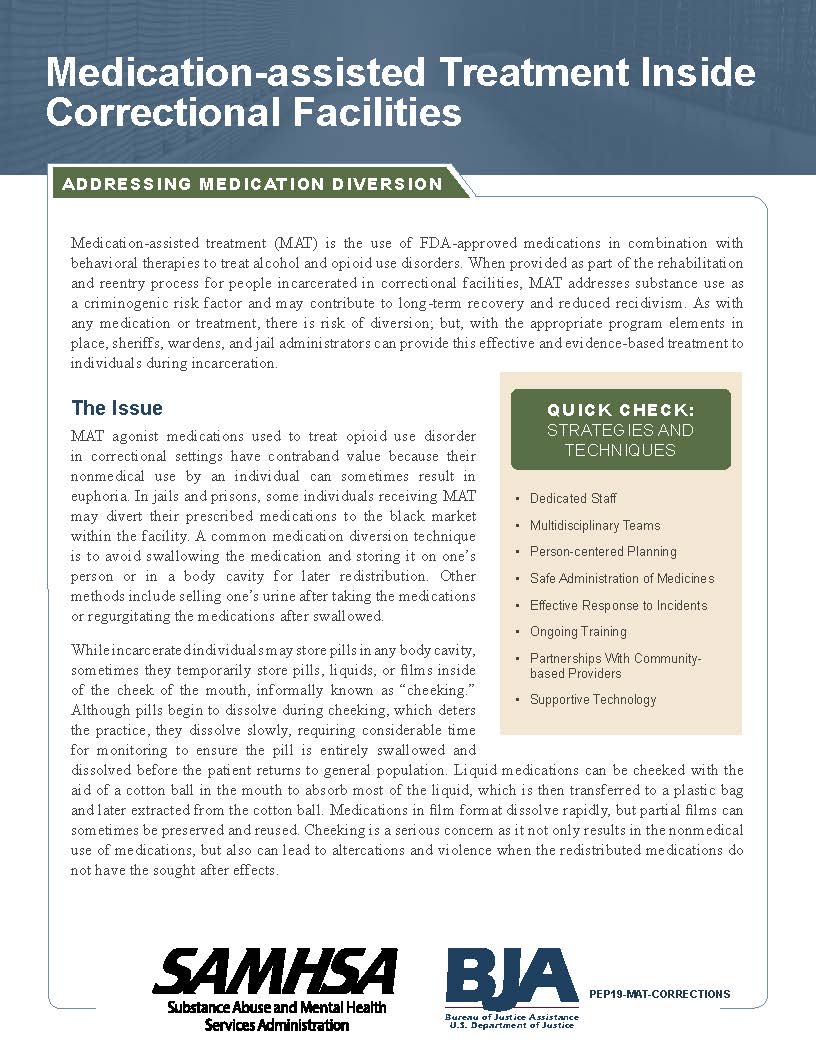Individuals with opioid use disorder (OUD) pass through jails each year, placing correctional facilities at the epicenter of the opioid crisis. Few jails offer the U.S. Food and Drug Administration-approved medications—buprenorphine, methadone, and naltrexone—that have consistently been shown to be the most effective forms of treatment for OUD when combined with behavioral therapies.
Ten communities are participating in the second Building Bridges demonstration project. The project began with a 9-month planning process, funded by the Bureau of Justice Assistance (BJA), to assist these teams in implementing medication-assisted treatment in their jails and enhancing collaboration between jails and community-based treatment providers. After the planning process, each community has received funding and support from BJA to support projects that increase the capacity of local communities to collaborate across the areas of public safety, behavioral health, and public health. Communities receive coaching and technical assistance from subject-matter experts as part of the project with the aim to develop a comprehensive continuum-of-care model that targets the jail population and builds bridges between in-custody and community-based treatment and supervision, including probation, parole, and court-based programs.
Reducing overdose deaths and recidivism by establishing effective, comprehensive in-custody treatment and maintaining continuity of services from jail to community-based supervision.
Highlights from BJA’s Building Bridges Between Jails and Community-Based Treatment Initiative Inaugural Meeting
On August 13–14, 2019, the Bureau of Justice Assistance (BJA)—as part of its Comprehensive Opioid, Stimulant, and Substance Abuse (COSSAP) Demonstration Project series and in collaboration with Arnold Ventures and other partners—convened teams from across the nation taking part in the Building Bridges Between Jails and Community-Based Treatment initiative to showcase best practices; share challenges and successes; advance respective sites’ planning processes; and provide the invaluable opportunity to engage with peers. BJA shares this video to spotlight participants’ insights and perspectives with the larger COSSAP community.
View the videoNew Publication! Orleans Reentry Court Program: Persistence, Peers, and Possibilities
The Orleans Reentry Court Program (ORCP) facilitates life-changing opportunities for incoming inmates to the Louisiana State Penitentiary at Angola and equips inmates with vocational, educational, and other skills that could lead to gainful employment, thereby reducing the likelihood of recidivism.
View ResourceSubstance Use Disorders and Treatment Among Jail Populations: Resources for Corrections Personnel
Jail practitioners and stakeholders asked for training on managing the well-being of inmates with opioid/substance use disorders. This collection of resources includes videos, online learning, and print documents that were screened specifically for corrections officers and other staff. Topics include foundational training on substance use disorders, withdrawal management in custody and MAT, and unique services that people with substance use disorders need as they reenter the community.
View the collection hereBuilding Bridges Between Jail and Community-Based Treatment for Opioid Use Disorder: Data Collection, Performance, Outcomes
This webinar presentation by BJA includes a discussion of the types of questions Building Bridges Between Jail and Community-Based Treatment for Opioid Use Disorder communities may want to answer about their projects as well as the performance measures that will be required for sites that may wish to pursue BJA funding, if available in the future. The discussion also includes identification of specific data elements from across the justice and health sectors that sites should consider collecting.
View the WebinarNew Resource: Medication-Assisted Treatment Inside Correctional Facilities
The Substance Abuse and Mental Health Services Administration’s GAINS Center recently developed a brief on addressing medication diversion, particularly for MAT agonist medications, in correctional settings.
View Resource




